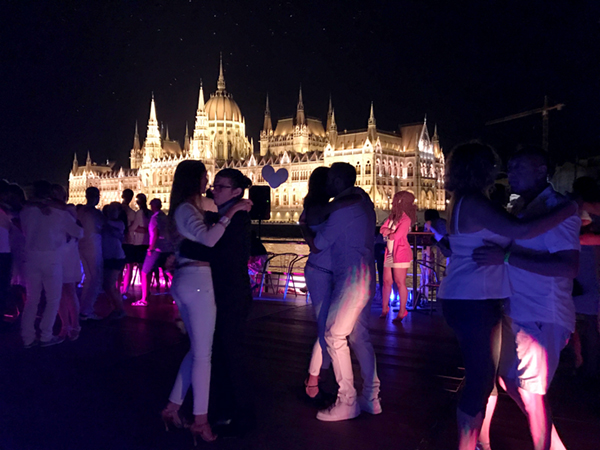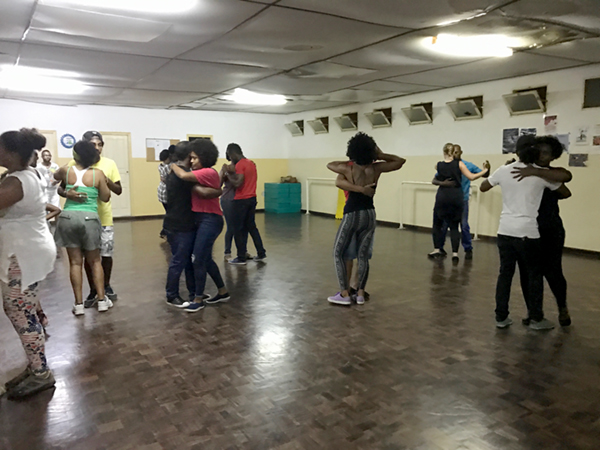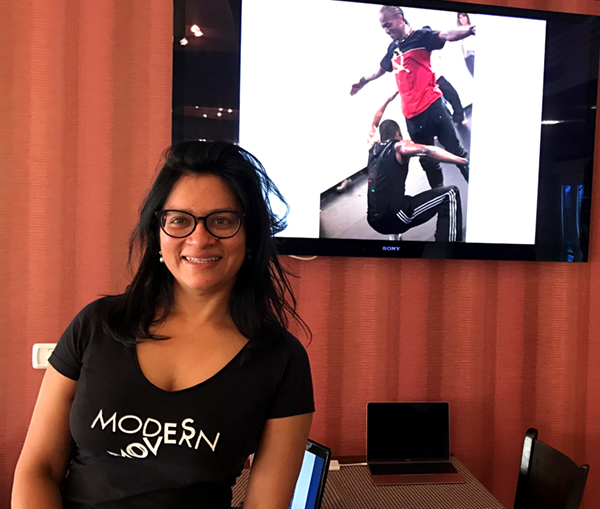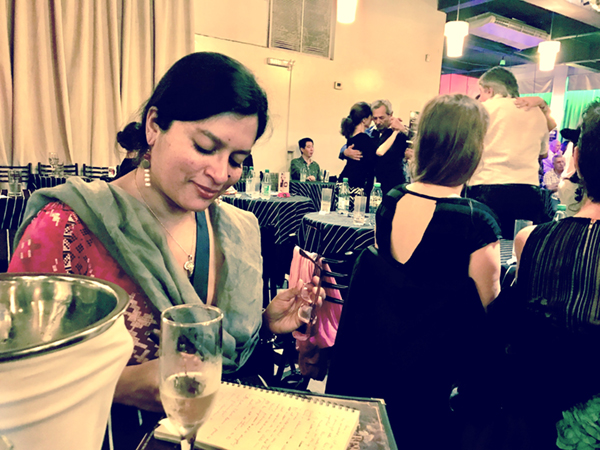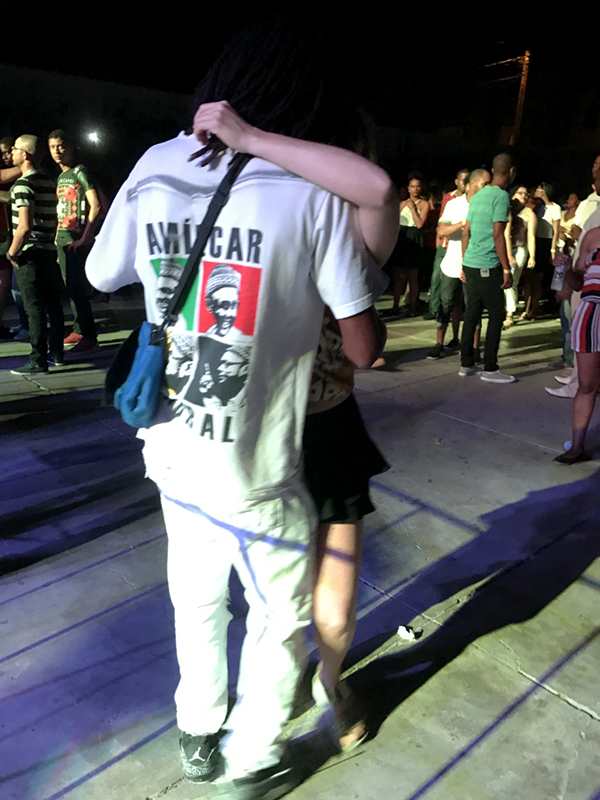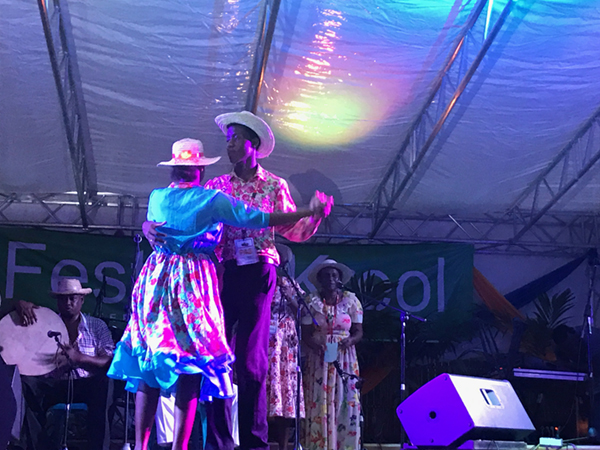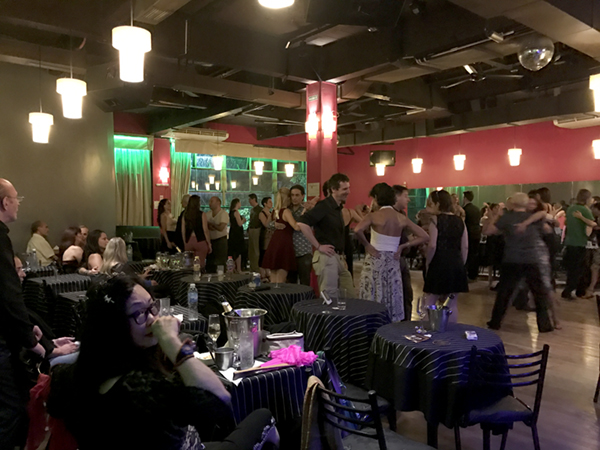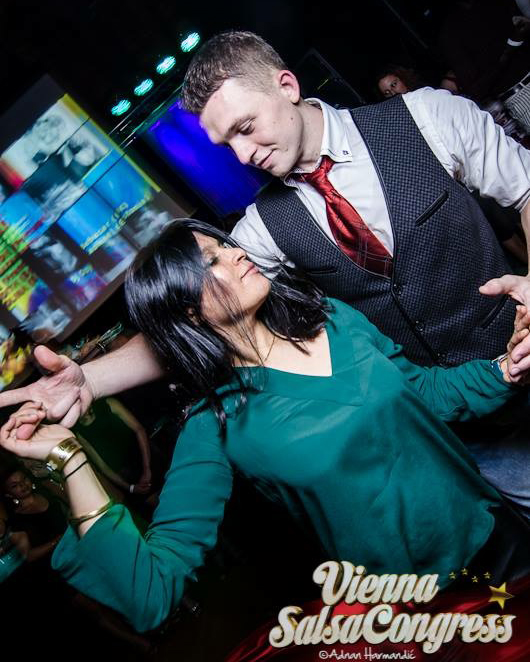Modern Moves’ Approach to Studying Afro-Diasporic Dance
An Interview with Ananya Jahanara Kabir
BY EMMALY WIEDERHOLT
Ananya Jahanara Kabir was the project director and principal investigator of Modern Moves: Kinetic Transnationalism and Afro-Diasporic Rhythm Cultures, a five-year research project (June 2013 – May 2018), funded by a European Research Council Advanced Grant, and located at the Department of English in King’s College London. The project asked: What is it about African-derived rhythms that inspire people to dance? Here, Ananya talks about the methodology in which she and her team tackled such a broad topic, as well as the importance of understanding the role of the dance floor and considerations of cultural appropriation.
Budapest Kizomba Connection, August 2017
~~
Can you tell me a little about your dance history?
Of course, like so many of us, I used to go to clubs to dance. Dance had always been there, but in an unstructured way. Around 2006 or 2007, things changed. I started learning Spanish. I like languages and wanted to try something new. In order to help me in my learning process, I started listening to some Latin music to practice my skills. I realized I was enjoying the rhythms of the songs and thought that perhaps it would be a good idea to start some dance classes. I thought salsa would be interesting, but I didn’t follow through until I happened to be in India, where I’m from, for two months one summer to see my dad. I discovered, to my astonishment, that there were now salsa classes in my neighborhood. What better time to start? I joined the classes, and it was a real eye opener to see through those classes how my city of Kolkata had changed – the kinds of people coming to the dance classes, the new social interactions, the groups of people being enabled – I could glimpse all this just from my weekly dance classes. Plus, I was also enjoying dancing, fused again with my continuing interest in Spanish.
I continued dancing when I got back to England. I was teaching at the University of Leeds at that time and living in Manchester. I continued my Spanish lessons through the Cervantes Institute, and took Cuban salsa classes there on the weekends. That was the start of my journey. I made friends through my classes and got more and more interested in the history of Cuba. My academic brain was working alongside my dancing body. I thought: This is where I want to go next with my research.
Kizomba class, Mindelo, Cape Verde, June 2017
What was the seed that led to the idea for Modern Moves?
The starting point was certainly my amazement at discovering the new relationships that salsa could trigger in a place like India, to which it had no historic connection. Salsa was not something known about when I was growing up. I realized Latin dance was a way to think about postcoloniality in the world. When I took salsa lessons back in England, I realized it was something bigger: People who would never have been in contact with each other were inhabiting the same world of the dance floor.
I realized I needed to build up a research question, and I wanted to devote solid time to that question. It was 2010 by now. I’d been dancing a couple of years by that point, and I started using my academic training to read books about Latin music and dance and think about what these forms meant in the world. I was also observing what was happening to me as a human being on the dance floor. I was getting out of an academic body into a kind of body I perhaps always had but had been a bit suppressed because of the life intellectuals (and ‘good Indian women,’ too) are expected to lead.
Bit by bit, I finished off my pending research obligations and started clearing space for what would become Modern Moves. I realized it was a very big project, and I would need big resources. I’d need to be patient and build up my skills and a profile that would allow a funder to give me big money. I was not a dance historian or dance scholar; I deal with literary texts. I had to prove that I knew what I was talking about.
Around that time, another dance called kizomba started penetrating the salsa scenes in Europe. I realized there was something interlinked about these dance forms. I couldn’t really constrain myself to thinking only about salsa so, thanks to kizomba, a bigger picture emerged. All that led to my applying in 2012 for a European Research Council Advanced Grant, the biggest amount of research grant money any single person can get in Europe, to research the history of those connections, of what I realized was really a deep history of certain couple dances that had formed through the encounter between African and European peoples because of complex and violent historic processes. All of that went into the application. I got the grant and began the project in 2013.
Ananya’s seminar at the Timisoara Salsa Addicted Festival, March 2017
How would you boil down the goal of Modern Moves for someone unfamiliar with it?
The question was very simple: How did dances formed through violent and traumatic histories, like that of slavery and colonialism, become a mode of exhilaration, joy and discovery for people around the world? Why is it that these dances, which are derived from the heritage of the African diaspora, have become so important as means of self-expression for people who may have nothing to do with that heritage, ethnically or culturally?
What was your work process like?
The methodology combined my experiences as a dancer and my technique of reading texts. I combined what I knew of reading culture through being a literary historian with what I wanted to say about culture through the moving body. This meant combining or analyzing the body as a text, and the text as a moving body.
If you want to know how any couple dance evolved, you’re going to have to go to a time when there were no videos. How would we even know how those dances looked, let along formed? You have to go to the archives, or written documents of different kinds. As a literary scholar, I am good at finding texts from a variety of colonial contexts where dance is described. Because I knew how the dance felt, I could fast forward in time and try and put the movement described in my body. I could feel the description of the text coming alive in my body. In this way, my research team tried to develop a methodology that broke the barrier between studying embodiment and studying written texts. We constantly tried to weave together how we felt and what we read to answer missing questions on both sides.
We asked: How is it that salsa could come out of slavery and yet be so joyful? In class, I’m imitating movements of Africans who were enslaved and brought to plantations. There’s a way in which history gets transmitted. We’re honoring that memory when doing those movements. If I want to understand how those movements came to be preserved, I may need to read texts that describe what a missionary may have seen on a plantation in the 17th century. I may have to read how the colonial masters tried to suppress those movements because they were seen as against law and order. Books can tell me all that, and then I do those movements. So there’s a cross pollination between the experience of feeling a dance in your body and going back through the archives to make sense of it.
Buenos Aires tango research, El Beso Milonga, April 2017
What are some areas of research that you particularly enjoyed or found enlightening?
One thing that became clear in the course of the research is that you can’t dance in isolation. That’s sort of a truism, but what does that mean when researching dance? Where do people dance? How do people get to places to dance? Those questions take us to a site that became really crucial for me and my team to zoom in on, which is the dance floor. What does a dance floor mean? It means there is a space in an economic structure, usually in a city, that is carved out to allow people to congregate and use technology and market economics to their advantage to find a few hours after work to enjoy themselves together through dance. The relationship of economics to structuring race relations as it resulted in a leisure-time activity – that triangulation: race, the market, and leisure within the modern urban space – became crucial to research findings. That relationship is not simple nor predictable. People are not selling out or capitulating to the market when they set up a Latin dance club. No, they have to work with the existing structure of the mainstream to carve out a space for resistance, survival and empowerment.
Second conclusion: This mode of collective human activity – gathering to dance on a dance floor – complicates very standard ways of thinking about cultural appropriation. This bring us to the tense and difficult relations between races, particularly in the Americas and Europe, because of the legacy of slavery. We can see how certain groups may, very rightly, consider these dances to be their legacy. Therefore, it’s a complicated situation when such cultural legacies become mainstream and go transnational. The market ensures that. The market is the channel in which such forms of cultural expression that came out of violence spread around the world. We want to say that it’s never sufficient to just lambast this process as one of cultural appropriation. Rather, we think that because of the way dance involves human beings in constant interaction, various sorts of complex yet unpredictable give and take of power can take place on the dance floor. This can even restructure difficult relations between opposed groups. In short, it is urgent and responsible for all of us thinking about any kind of dance that has come out of Black culture to consider the issue of cultural appropriation that may arise through those dances going mainstream and global. Our research taught us that dance is never predictable nor simple, and it’s a means to share power and also turn power relations around.
Cape Verde Festa Sanjon, June 2017
Given the history of Afro-diasporic forms being marginalized in the dance field, how might Modern Moves influence the culture and value of Afro-diasporic dances in the larger dance field?
At the moment, there are quite a few dance scholars working on this issue. Because race relationships in the US are so difficult, it becomes a very tense space from where to ask what is going on when people who are not from the heritage of the African diaspora engage with these dances. These questions re-layered with what the scholar Eric Lott called ‘Love and theft’: There’s always going to be white people who seem to be stealing Black people’s moves and music to make more money than Black people can with those same cultural resources.
Against all that, which we are rightly calling cultural appropriation, there’s another kind of interaction that has been always going on. That interaction is more complex than just black and white. It’s not a binary; there’s a constant flux of power, desire, and wanting to be like the other, and of using dance to do that. When you mimic someone, at some point the power of mimicry can do strange things to the partition between ‘self’ and ‘other,’ ‘you’ and ‘us.’
How has the research been disseminated in ways that might impact or affect dance and music practitioners?
I’m writing a book on the subject, Alegropolitics, that will hopefully be out in the world in a couple of years. I intend it to be a book for people to enjoy and think through. It’s going to be interspersed with a lot of my own dance experiences. It’s also going to explore this issue of: Where is the meaning of connection on the dance floor, why do we need to connect, and what are the consequences for those questions about African heritage and history? It’s about pretty much what I’m calling the politics of happiness and joy. We all want to feel good, and we’ve found it in different forms of Black dance. I’m turning around what is often said and instead saying it’s a gift of the African diaspora to the world. At the same time, I don’t want to lose sight of the nitty gritty of economics, the market, and racialized politics.
I want to move beyond binaries and a simple understanding of the give and take of culture. The word for that process that I’m favoring is “creolization” – a process that creates unexpected new things out of violent and unpredictable cultural encounters. I would say that the dances we’re talking about are creolized dances.
Seychelles, Festival Kreol, October 2017
How has your identity and background as an Indian, as well as your funding and location in Europe, shaped the project, as best that you can tell?
All my research has been shaped by what I feel is my advantage, which is coming to my topic with a bit of an outsider perspective. Being an outsider always is important because it allows you to do what an academic must do – be a bit dispassionate and skeptical, and be a bit distanced from whatever the analysis is. However, being a bit of an insider also helps. Through dance, I was drawn inside the scene. That process certainly has complicated my initial statement of being an outsider. In that way, I am simultaneously an insider and outsider. Being an insider allows me to feel the passion. People around the world spend enormous amounts of energy, emotion, resources and time learning these dances. Chasing my dance across the world has made me feel the power of these dances. That makes me an insider. But strictly from the point of view of heritage, I am an outsider. I am neither Latina nor African diasporic in any way. I did not grow up in any part of the Americas and thus don’t connect culturally in that way either. Academically too, my training is neither dance nor ethnomusicology. But I learnt about all those things and am able to both feel an affection and passion for what I’m studying without feeling there is so much at stake with my own identity. This has helped me shape my approach to dance.
What’s next for you?
I was really lucky because I managed to get some time off to write this book, thanks to a research award from the Alexander von Humboldt Foundation in Germany. Running Modern Moves was too hectic and took up all my energy. I’m now clearing my desk and my head, rereading certain key texts, listening to a lot of music, and revising my feeling of joy by attending a few dance festivals. I’ve just been to one in Paris and Luxembourg, and am now attending the MamboCity congress in London. I’m doing these festivals in the middle of my writing plans because I want to remind myself of that crazy passion that people feel for these dances. It’s important to recapture what that feels like for me as I start writing. I don’t want it to be a book that’s devoid of passion and love for the dance. It’s a bit tricky because writing is a very cerebral activity but writing about dance must get the body involved. This is not my first book, but it’s certainly my first book about physicality. Hopefully, I can keep the balance going and the book that emerges will pay homage to all the people I’ve met on the dance floor and all the ancestors of the creolized world who gave us these powerful, joyous, and strong ways of connecting to each other.
Buenos Aires, El Beso Milonga, April 2017
As I’m writing the book, I’m already thinking of my next project. While this next project may not be completely about dance, it will think seriously about different embodied and sensuous histories. I moved to dance because it was a challenge to capture the human body through writing. Now, I want to attempt to capture more difficult things – taste, touch, and smell. Working in dance has made me more sensitive to the histories of the body.
Any other thoughts?
It’s been more than 10 years since I entered the world of Afro-Latin dance. I myself moved through 10 years of my life. Working on dance has made me realize the fragility of the body and how we evolve. As time passes, the dance scene changes because the people come and go; they often return, but they return changed. I’ve become very conscious about how we can’t take our bodies for granted and the precarious joy of dance because our bodies are precarious.
At the Paris festival, I met people I hadn’t danced with for a few years because I was so busy with my project, ironically. I felt so happy. Dancing with them, it felt like we were connecting like we always did. That is the biggest gift of social dance. We are made more aware of our bodies, and how susceptible we are to the passing of time, but, somehow, we also gain some power over the passing of time when we are in that dance.
~~
To learn more, www.modernmoves.org.uk.
Vienna Salsa Congress, December 2016
Photo by Adnan Harmandic

